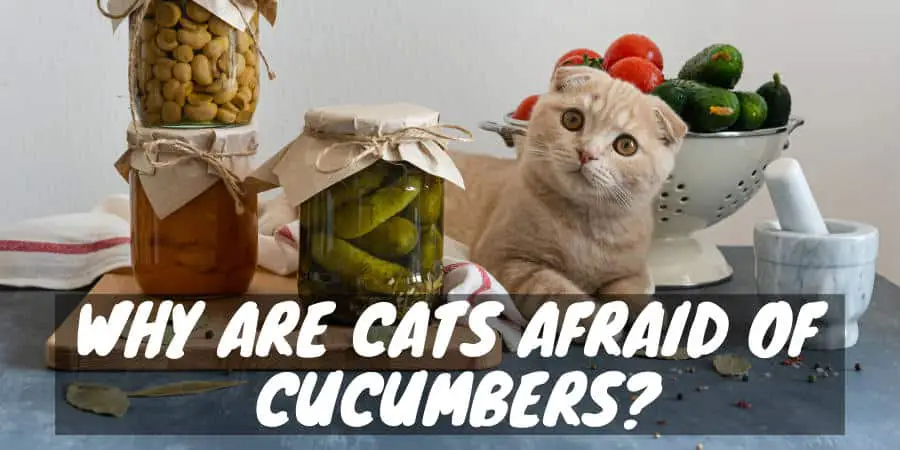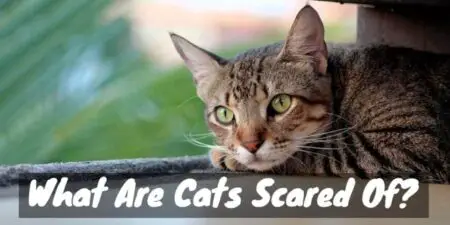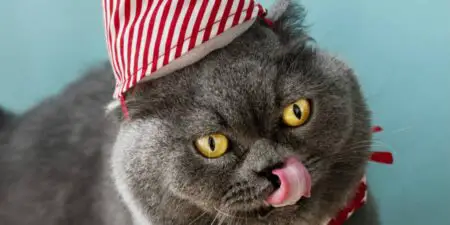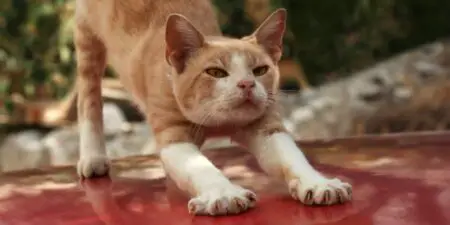You’ve seen the viral videos and maybe even tried the trick out on your own cat. Just put a cucumber behind him, wait for him to turn around and watch him jump out of his skin in fright.
There’s no denying that it’s an amusing reaction. Here you have an apex predator, a bonafide killing machine, put in his place by an inanimate vegetable.
But you can’t help but empathize with those poor, unsuspecting cats. The turn-around scare is a horror movie staple for a reason: being startled by something behind your back is guaranteed to get your heart racing and your hair standing on end.
And there’s a third angle to the cat-cucumber relationship: the curious one. Why are cucumbers so alarming to cats?
Unfortunately, we can’t get the answer straight from the cat’s mouth. But we’ve got a couple of theories — ready to hear them?
Cats and Cucumbers: Two Theories Behind the Fear
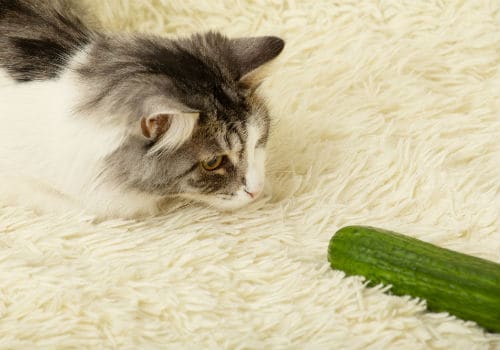
The Evolutionary Theory: Cucumbers Look Like Snakes
In the wild, there aren’t too many predators that can take on felines. They’re just too sneaky, cunning, quick and powerful to fall victim to typical attacks.
But some predators can get the upper hand over a cat by virtue of their stealthy movements. One such predator: the snake.
Able to slither up, down and all around without making a sound, a snake can sneak up on even the wariest of cats. Then it’s just a matter of sinking those venomous fangs into a paw or leg.
By the time the cat realizes what’s happening, it’s too late. Millenia of experience has taught felines that snakes are bad news, and they’re instinctively averse to anything that resembles one.
Now, to us, a cucumber looks like a cucumber. But if you only saw it out of the corner of your eye, or caught a split-second glimpse of it as you turned your head, you’d be forgiven for confusing it for a snake.
After all, it’s long, green and largely featureless. And its textured skin can resemble a snakeskin at a glance.
When a cat comes face-to-face with something that resembles a snake, he has just a fraction of a second to make the call: assume it’s a snake and flees, or assume it’s not and potentially get bit.
A simple risk analysis produces an obvious answer. Better to jump and run away from nothing than to leave yourself vulnerable to a deadly predator.
The Psychological Theory: Unexpected Objects Are Startling
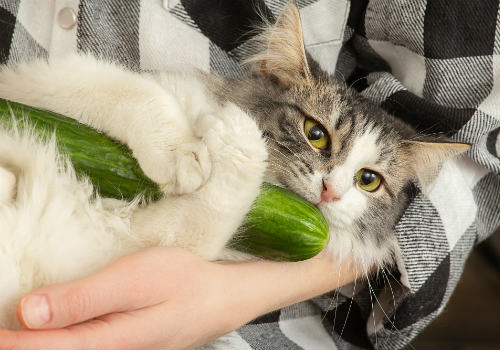
This theory takes the basis of the snake theory — it’s scary to turn around and see a snake — and expands it.
Snakes aren’t the only things that are alarming to find behind your back. Anything unexpected would provoke the same response, and that’s what’s happening with cats and cucumbers.
Before the cucumber appears, the cat is comfortable with his surroundings because he knows them well. He knows that there’s a couch and a coffee table behind him — he’s been here many times and when he walked in just now, he confirmed that everything was as he remembered it.
So he goes about his business, maybe bathing himself or staring at that empty spot on the wall he likes so much.
But then he turns around and sees that things aren’t as he thought they were.
There’s now a weird object on the ground that he hasn’t seen before, and what’s more, he didn’t notice it arrive at all. It didn’t make noise, he didn’t see it, and he didn’t feel it — it’s as if it materialized out of thin air.
This type of experience would make anyone question reality and feel uneasy or downright frightened. If you were standing alone in your living room, then turned around and saw that a strange object appeared out of nowhere, you’d probably get the heebie-jeebies, too!
It’s normal for cats to be startled when something sneaks up on them, be it a snake, a person or a cucumber. This expression of fear is evolutionarily advantageous: it gets them away from the unknown object so they can evaluate the threat from a safe distance.
Bottom Line: Don’t Try This at Home!
Whatever the reason, it’s clear that cats don’t like having cucumbers placed behind them. It startles them and makes them feel afraid in a place that’s supposed to be safe and comforting.
In other words, it’s mean to intentionally scare your cat, even if you do it with a harmless cucumber.
Objects don’t need to be physically dangerous to harm your cat psychologically. When you adopted him, you made a commitment to keep him happy and safe, and scaring him on purpose breaks that commitment for a few laughs.
Cats are amusing in so many ways that they don’t require you to break their trust. So get out the laser pointer or the catnip if you want some feline entertainment, and leave that cucumber in the fridge where it belongs!
"In ancient times cats were worshipped as gods; they have not forgotten this."
-- Terry Pratchett

